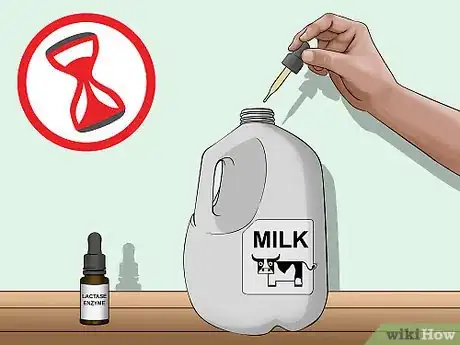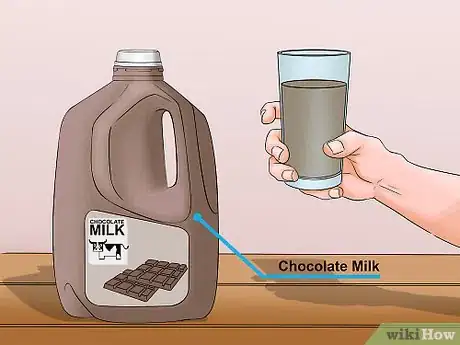This article was co-authored by Alan O. Khadavi, MD, FACAAI. Dr. Alan O. Khadavi is a Board Certified Allergist and a Pediatric Allergy Specialist based in Los Angeles, California. He holds a BS in biochemistry from the State University of New York (SUNY) at Stony Brook and an MD from the State University of New York Health Science Center at Brooklyn. Dr. Khadavi completed his pediatric residency at Schneider Children’s Hospital in New York, and then went on to complete his allergy and immunology fellowship and pediatric residency at Long Island College Hospital. He is board certified in adult and pediatric allergy/immunology. Dr. Khadavi is a Diplomate of the American Board of Allergy and Immunology, a Fellow of the American College of Allergy, Asthma & Immunology (ACAAI), and a member of the American Academy of Allergy, Asthma & Immunology (AAAAI). Dr. Khadavi's honors include Castle Connolly’s list of Top Doctors 2013-2020, and Patient Choice Awards "Most Compassionate Doctor" in 2013 & 2014.
This article has been viewed 50,412 times.
Milk is a common staple of many people’s diets. But if you’re lactose intolerant, drinking milk can result in some unpleasant bodily reactions. Fortunately, there are a few ways to get around the pesky irritant so you can enjoy milk to your heart's content. We'll show you how to use lactase or probiotics to help consume regular milk, as well as guide you to some worry-free milk alternatives.
Things You Should Know
- Add 7 drops of lactase enzymes to a pint of milk and let it sit in the fridge for 24 hours to break down lactose.
- Take lactase tablets or other probiotic supplements before you drink milk to help with digestive trouble.
- Opt for milk products with lactose already removed, or non-dairy alternatives like soy or almond milk.
Steps
Using Lactase and Probiotics to Break Down Lactose
-
1Add lactase enzymes to milk before you drink it to break down lactose. When they’re added to cow’s milk, lactase enzymes break down the milk’s lactose before it enters your body. Add the lactase enzymes to the milk and let it sit in the refrigerator for 24 hours to reduce its lactose content by up to 70%. Add 7 drops of lactase per pint of milk, unless the package instructions say otherwise.[1]
- You can buy lactase enzymes in most pharmacies and vitamin shops. For best results when adding it to milk, buy the lactase enzymes in liquid drop form.
-
2Take lactase tablets before you drink milk to make digesting it easier. If you’re lactose intolerant, your body doesn’t produce enough natural lactase to break down lactose when you drink it. Take the tablets immediately before drinking milk to help your body break down the lactose and avoid the symptoms of lactose intolerance.[2]
- Most people will only need to take 1-2 tablets before they drink milk. However, if you’re not sure how many tablets you should take, refer to the dosing instructions on your supplements package.
- Although most people have no problems taking lactase tablets, they can cause an allergic reaction in some people. The symptoms of this type of reaction include hives, difficulty breathing, and a tightness in your chest.
- Not enough research has been done on the effects of taking lactase to know what effect it has on pregnant and breastfeeding women. If you’re pregnant, avoid taking lactase tablets just to be on the safe side.
Advertisement -
3Try taking probiotic supplements that may aid in digesting lactose. Some studies have shown that certain probiotic supplements produce bacteria in your gut that help break down lactose. Take 1 dose every day of a commercial probiotic that helps break down lactose in order to reduce your symptoms of lactose intolerance over time.[3]
- Most probiotic supplements that aid in the digestion of lactose will include this information on the front label. However, the best specific bacteria strains to have in your probiotic are Bifidobacterium longum, Lactobacillus rhamnosus Rosell-11, and Lactobacillus acidophilus Rosell-52.
Finding Alternatives to Cow’s Milk
-
1Buy lactose-free milk that has already had its lactose removed. Many grocery stores and supermarkets carry milk that had all or most of the lactose removed during the production process. Plus, lactose-free milk still has all the vitamins and nutrients of regular milk, meaning it’s just as healthy![4]
- Note that lactose-free and lactose-reduced milk tend to be a bit more expensive than regular milk. However, depending on how much milk you drink, it’s probably less expensive in the long run than buying lactase enzymes from a vitamin shop.
-
2Try drinking chocolate milk if you find it doesn’t affect you. Some lactose intolerant people have found that when they drink chocolate milk, they don’t experience any of the symptoms associated with drinking regular milk. If your lactose intolerance isn’t very severe, give chocolate milk a try to see if you have any trouble tolerating it.[5]
- There are a few different ideas as to why chocolate milk produces less symptoms of lactose intolerance. Some scientists argue cocoa may stimulate lactase activity in the body, while others think it might reduce the number of gas-producing bacteria in the colon.
- Not everybody will be able to tolerate chocolate milk equally well. Try it in small amounts at first to see if your body reacts to it before gulping down a tall glass.
-
3Opt for a non-dairy milk to have naturally lactose-free milk. Soy milk, rice milk, and a variety of milks made out of nuts are all widely available in grocery stores and supermarkets. Although these non-dairy products tend to be more expensive than regular milk, they still provide all the nutrition benefits of regular milk and taste just as good.[6]
- Soy milk in particular has also been found to contain less saturated fat than cow’s milk and is better at reducing “bad” cholesterol levels in the body.
-
4Drink milk with food if you don’t have any alternatives. When you consume milk with other foods, your body digests it more slowly. This means that by the time the lactose gets to your intestines, where it produces the symptoms of lactose intolerance, there’s less of it left. Limit your intake of milk to mealtime to still get the benefits of drinking it while minimizing your negative symptoms.[7]
Community Q&A
-
QuestionHow can I determine if there is lactose in milk?
 Community AnswerIf it came from an animal (cow, goat, etc.), and the container does not specifically state that it is lactose-free or removed, it will contain lactose. Alternatively, you can buy caplets that you stir into a glass of milk to break down lactose.
Community AnswerIf it came from an animal (cow, goat, etc.), and the container does not specifically state that it is lactose-free or removed, it will contain lactose. Alternatively, you can buy caplets that you stir into a glass of milk to break down lactose.
Warnings
- It is a common misconception that boiling milk can remove lactose. Although boiling milk is a good way to kill any bacteria that may be in it, it won’t make it any easier to drink if you’re lactose intolerant.⧼thumbs_response⧽
References
- ↑ https://www.sciencelearn.org.nz/resources/2015-treating-lactose-intolerance
- ↑ https://www.verywellhealth.com/the-benefits-of-lactase-supplements-89470
- ↑ https://clinicaltrials.gov/ct2/show/NCT01593800
- ↑ https://www.mayoclinic.org/diseases-conditions/lactose-intolerance/diagnosis-treatment/drc-20374238
- ↑ https://thedairyalliance.com/chocolate-milk-for-lactose-intolerance/
- ↑ https://www.mayoclinic.org/diseases-conditions/lactose-intolerance/diagnosis-treatment/drc-20374238
- ↑ https://www.mayoclinic.org/diseases-conditions/lactose-intolerance/diagnosis-treatment/drc-20374238


























































